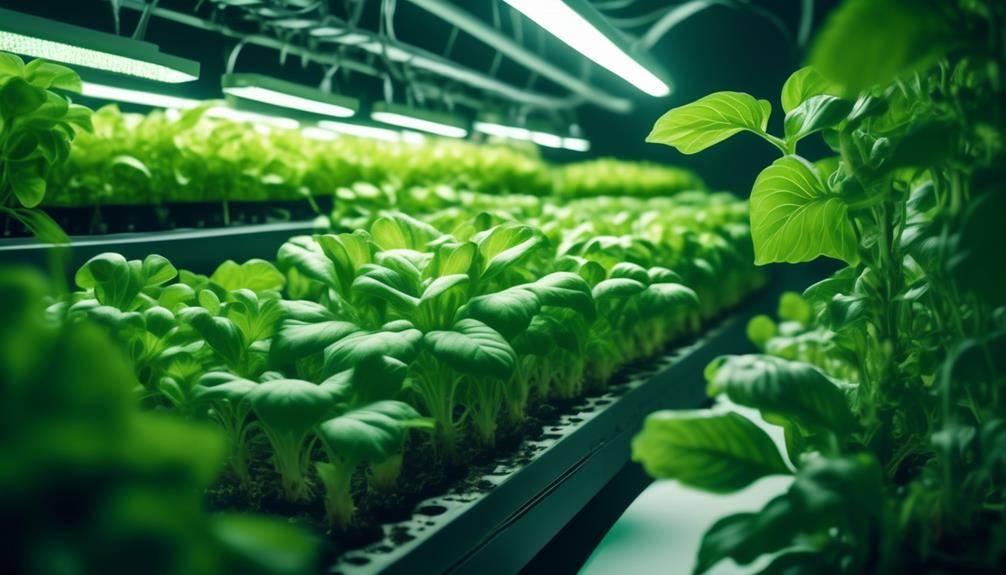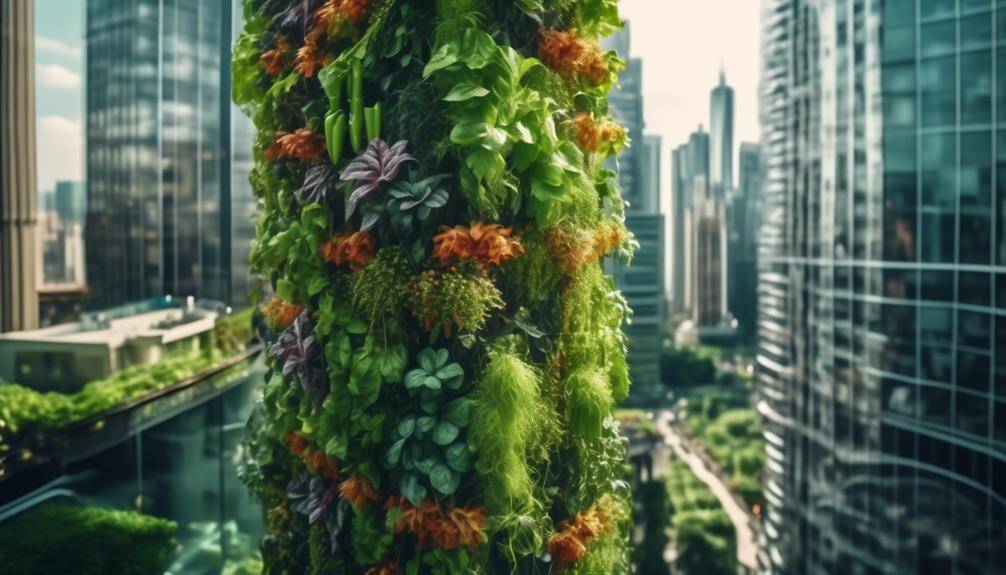Top 13 Way’s How Hydroponics Is Changing Farming

How Hydroponics Is Changing Farming; By chance, have you ever wondered how hydroponics is revolutionizing the field of farming? Well, brace yourself for a fascinating journey into the world of modern agriculture. Hydroponics, a method of growing plants without soil, has been gaining traction in recent years due to its numerous advantages. From conserving water and maximizing crop yield to enabling sustainable agriculture and year-round production, hydroponics is reshaping the way we grow food. But that’s not all – there are even more benefits that await you as we unravel the impact of hydroponics on farming. So, let’s dive into this transformative technology and explore the ways it’s changing the face of agriculture.
Water Conservation
Hydroponics offers a sustainable solution to water conservation in farming by utilizing a soilless system that maximizes efficiency and minimizes waste. With traditional soil-based farming methods, a significant amount of water is lost through evaporation, runoff, and inefficient irrigation techniques. However, hydroponics eliminates these issues by providing a controlled environment where water efficiency is prioritized.
One of the key advantages of hydroponics is its ability to precisely regulate water usage. In traditional agriculture, water is often wasted due to overwatering or inefficient irrigation systems. Hydroponics, on the other hand, allows for targeted watering directly to the plant roots, ensuring that only the necessary amount of water is used. By eliminating the need for excessive watering, hydroponics reduces water wastage significantly.
Another water-saving technique used in hydroponics is the recirculation of nutrient-rich water. In this system, water is continuously circulated through the growing medium, delivering nutrients to the plants and then recaptured, filtered, and reused. This closed-loop system minimizes water waste and maximizes efficiency, as opposed to traditional farming methods that require constant water replenishment.
Furthermore, hydroponics offers the advantage of reducing water pollution caused by runoff. In traditional farming, excess water and chemicals used in irrigation can seep into the ground, contaminating water sources. With hydroponics, the water is contained within the system, preventing any potential pollution and ensuring that the water remains clean and free from harmful substances.
Maximizing Crop Yield
To maximize crop yield, farmers can employ various techniques and strategies that optimize plant growth and productivity. By maximizing crop resilience and optimizing planting techniques, farmers can ensure that their crops reach their full potential. Here are five effective methods that can help farmers achieve higher crop yields:
- Crop rotation: Planting different crops in a specific sequence can reduce disease and pest pressure, improve soil fertility, and boost overall crop productivity. By rotating crops, farmers avoid depleting specific nutrients from the soil, leading to healthier plants and higher yields.
- Precision agriculture: Utilizing technology such as GPS and sensors, farmers can precisely manage inputs like water, fertilizer, and pesticides. This approach allows for more targeted and efficient application, reducing waste and maximizing crop yield while minimizing environmental impact.
- Integrated pest management (IPM): IPM combines various pest control methods to minimize the use of chemical pesticides. By incorporating biological controls, cultural practices, and monitoring techniques, farmers can effectively manage pests while maintaining crop health and productivity.
- Enhanced nutrient management: Implementing advanced nutrient management practices, such as controlled-release fertilizers and foliar feeding, can optimize nutrient uptake by plants. By providing crops with the right balance of essential nutrients, farmers can enhance growth, increase yields, and improve overall crop quality.
- High-quality seed selection: Choosing high-quality seeds adapted to local conditions is crucial for maximizing crop yield. By selecting seeds with desired traits, such as disease resistance, drought tolerance, and high yield potential, farmers can optimize plant performance and increase their chances of achieving higher yields.
Sustainable Agriculture
Sustainable agriculture practices are essential for ensuring the long-term viability and environmental stewardship of farming systems. With the increasing concern for the impact of conventional farming methods on the environment, there has been a growing interest in sustainable practices, such as organic farming.
Organic farming is a key component of sustainable agriculture. It emphasizes the use of natural methods to maintain soil fertility, control pests, and manage weeds, without relying on synthetic chemicals or genetically modified organisms. By avoiding the use of synthetic fertilizers and pesticides, organic farming reduces the risk of water and soil pollution, protects biodiversity, and promotes healthier ecosystems.
In addition to its environmental benefits, organic farming also has social and economic advantages. It promotes the use of local resources, such as compost and organic matter, reducing the dependence on external inputs. This not only helps to improve the soil’s structure and fertility but also reduces the costs for farmers. Moreover, organic farming often involves direct sales to local markets, allowing farmers to receive fair prices for their produce and fostering a stronger connection between producers and consumers.
To further enhance sustainability in agriculture, farmers can adopt other practices such as crop rotation, agroforestry, and water conservation techniques. Crop rotation helps to prevent soil depletion by alternating the types of crops grown in a particular area. Agroforestry combines trees and crops, providing multiple benefits such as carbon sequestration and increased biodiversity. Water conservation techniques, such as drip irrigation or rainwater harvesting, reduce water waste and promote efficient water usage.
Space Efficiency
When it comes to space efficiency in hydroponics, there are several key points to consider. First, vertical growing systems allow for the cultivation of plants in a stacked manner, maximizing the use of available space. Second, compact cultivation methods, such as nutrient film technique or aeroponics, enable plants to be grown in a more condensed manner, further optimizing space utilization. Lastly, hydroponics allows for the efficient use of limited spaces, making it possible to grow crops in urban areas or areas with limited arable land.
Vertical Growing Systems
Vertical growing systems offer a space-efficient solution for maximizing crop production in limited areas. These innovative techniques have revolutionized the way we grow plants, allowing farmers to overcome the limitations of traditional farming methods. Here are five key aspects of vertical growing systems that highlight their space efficiency:
- Vertical stacking: By growing plants in stacked layers, vertical systems utilize the vertical space, making the most of available square footage.
- Tower systems: Tower systems consist of vertical columns with multiple planting levels, enabling farmers to grow a large number of crops in a small footprint.
- Hanging gardens: Hanging gardens utilize vertical space by suspending plants from overhead structures or walls, effectively turning unused spaces into productive growing areas.
- Vertical hydroponics: Vertical hydroponic systems allow plants to grow without soil, using nutrient-rich water solutions. This eliminates the need for large soil beds, further maximizing space efficiency.
- Modular design: Vertical growing systems often feature modular designs, allowing farmers to easily expand their operations by adding additional units, vertically or horizontally.
These vertical farming benefits and vertical growing techniques demonstrate the potential of vertical growing systems to revolutionize agriculture and address the challenges of limited space. By utilizing the vertical dimension, farmers can significantly increase crop yields while minimizing the land area required.
Compact Cultivation Methods
Compact cultivation methods offer a space-efficient solution for maximizing crop production in limited areas. These compact farming techniques are particularly relevant in the context of urban agriculture, where space is often at a premium. By utilizing innovative methods such as vertical growing systems or stacking planters, farmers can optimize the use of available space and grow more crops in smaller areas. This not only allows for increased food production but also reduces the need for extensive land use.
Compact cultivation methods also enable urban farmers to bring agriculture closer to the consumers, minimizing transportation costs and carbon emissions associated with long-distance food distribution. Overall, these techniques play a crucial role in addressing the challenges of limited space in urban environments, promoting sustainable and efficient farming practices.
Utilizing Limited Spaces
To address the challenges of limited space in urban environments, farmers can employ space-efficient techniques that optimize crop production in smaller areas. Here are five innovative farming techniques that maximize productivity in limited spaces:
- Vertical farming: By growing plants vertically in stacked layers, farmers can utilize the vertical space and increase overall crop yield.
- Tower gardens: These vertical structures allow for the cultivation of plants in a compact and controlled environment, using less water and soil.
- Aquaponics: This system combines hydroponics with aquaculture, where fish waste provides nutrients to the plants, creating a symbiotic relationship that maximizes productivity.
- Microgreens: These nutrient-packed, fast-growing greens can be grown in small trays or containers, making them ideal for limited spaces.
- Container gardening: Using containers, such as pots or raised beds, allows farmers to grow a variety of crops even in areas with no soil, such as rooftops or balconies.
With these space-efficient techniques, farmers can overcome the limitations of limited space and continue to feed urban populations sustainably.
Year-Round Production
When it comes to year-round production, hydroponics offers several advantages. Firstly, it allows for increased crop availability, as plants can be grown regardless of the season. Secondly, hydroponics enables efficient resource utilization, as water and nutrients can be carefully controlled and recycled. Lastly, this method of farming reduces environmental impact by minimizing the use of pesticides and herbicides, as well as conserving water compared to traditional soil-based agriculture. Overall, year-round production through hydroponics is a promising solution for sustainable and reliable food production.
Increased Crop Availability
Increased crop availability is one of the key benefits of hydroponics, allowing for year-round production regardless of seasonal limitations. With technological advancements in hydroponic systems, farmers can now grow a wide variety of crops throughout the year, ensuring a constant supply of fresh produce. The following bullet list illustrates the increased crop availability made possible by hydroponics:
- Leafy greens, such as lettuce and spinach, can be grown continuously, ensuring a steady source of nutritious greens.
- Fruits like strawberries and tomatoes can be harvested multiple times a year, providing a consistent supply of these popular fruits.
- Herbs, such as basil and mint, can be grown year-round, allowing for a constant availability of fresh flavors.
- Root vegetables, like radishes and carrots, can be produced consistently, ensuring a stable supply of these staple ingredients.
- Exotic crops, such as tropical fruits and specialty herbs, can be cultivated in controlled environments, expanding the variety of crops available to consumers.
Efficient Resource Utilization
Hydroponics revolutionizes farming by maximizing resource utilization through year-round production. With traditional farming methods, crops are typically grown seasonally, leading to a significant waste of resources during off-seasons. However, hydroponics allows for continuous cultivation, ensuring efficient use of resources such as water, nutrients, and energy. By controlling the growing environment, hydroponics enables farmers to optimize resource management and minimize wastage. This method also reduces the need for excessive land use and eliminates the dependency on external factors like weather conditions. Additionally, the controlled environment in hydroponics systems allows for the precise delivery of nutrients, resulting in higher crop yields and reduced input costs. Overall, hydroponics offers a cost-effective and sustainable solution for year-round production, maximizing resource utilization in farming.
Reduced Environmental Impact
To further explore the benefits of hydroponics in farming, let’s now examine its role in reducing the environmental impact through year-round production. Hydroponics offers several advantages that contribute to a reduced carbon footprint and soil preservation:
- Consistent harvest: With hydroponics, crops can be grown year-round, regardless of seasonal limitations. This eliminates the need for importing produce from distant locations, reducing transportation emissions.
- Water conservation: Hydroponic systems use up to 90% less water compared to traditional soil-based farming methods. The water is recirculated within the system, minimizing wastage and preserving this precious resource.
- Reduced pesticide use: By controlling the growing environment, hydroponics reduces the need for chemical pesticides, minimizing soil contamination and protecting biodiversity.
- Efficient resource utilization: Hydroponics maximizes nutrient uptake, resulting in less fertilizer runoff and pollution of nearby water bodies.
- Land preservation: Hydroponics requires less land compared to traditional farming, allowing for the preservation of natural habitats and reducing deforestation.
Reduction in Pesticide Use
By adopting hydroponic farming methods, farmers can significantly reduce their reliance on pesticides while still maintaining high crop yields. This shift towards reduced chemical dependency has numerous health benefits for both farmers and consumers.
Hydroponic systems, which involve growing plants in a nutrient-rich water solution rather than soil, offer a controlled environment that minimizes the risk of pest infestations. The absence of soil eliminates the need for soil fumigation and reduces the use of chemical pesticides. Instead, hydroponic farmers rely on integrated pest management (IPM) techniques, such as biological controls, beneficial insects, and physical barriers, to manage pests effectively.
Research has shown that hydroponic farming can significantly decrease pesticide use. A study conducted by the University of Arizona found that hydroponic lettuce production required 70% less pesticide usage compared to traditional soil cultivation. Similarly, a study published in the Journal of Agricultural and Food Chemistry found that hydroponically grown tomatoes had lower pesticide residues compared to conventionally grown tomatoes.
Reducing pesticide use in agriculture has several health benefits. Pesticides have been linked to various health issues, including respiratory problems, allergies, and even cancer. By minimizing pesticide exposure, hydroponic farming helps protect the health of farmers who work closely with these chemicals and consumers who consume the crops.
Moreover, hydroponic systems allow for the production of pesticide-free and organic crops, meeting the increasing demand for healthier and safer food options. With the rising concerns about pesticide residues in conventional produce, hydroponics provides a viable solution to produce high-quality, pesticide-free fruits and vegetables.
Nutrient Optimization
When it comes to hydroponics and nutrient optimization, there are several important points to consider. First, hydroponic systems allow for enhanced nutrient absorption by providing plants with a precise balance of nutrients in their water solution. This results in reduced nutrient waste and better utilization by the plants. As a result, hydroponics can lead to improved crop yields and overall productivity in farming.
Enhanced Nutrient Absorption
Enhanced nutrient absorption plays a crucial role in optimizing the nutrient intake for hydroponic plants. By providing plants with the ideal conditions for nutrient uptake, hydroponic systems can significantly improve plant growth and produce nutrient-rich crops. Here are five ways in which enhanced nutrient absorption is achieved in hydroponics:
- Nutrient-rich water: Hydroponic systems deliver nutrient solutions directly to the plant roots, ensuring they have constant access to the necessary nutrients.
- pH regulation: Maintaining the optimal pH level in the nutrient solution allows plants to absorb nutrients more efficiently.
- Controlled nutrient ratios: Hydroponics enables precise control over nutrient ratios, ensuring plants receive the right balance of essential nutrients for healthy growth.
- Root zone oxygenation: Oxygen is supplied to the plant roots in hydroponic systems, promoting better nutrient uptake and overall plant health.
- Absence of soil-borne diseases: By eliminating soil, hydroponics reduces the risk of plant diseases and allows for better nutrient absorption.
These techniques contribute to increased nutrient absorption and ultimately lead to improved plant growth and the production of nutrient-rich produce in hydroponics.
Reduced Nutrient Waste
To optimize nutrient usage in hydroponic systems, reducing nutrient waste is essential. Minimizing waste is a key aspect of sustainable practices in hydroponics. Unlike traditional soil-based farming, where nutrients can be lost due to leaching, hydroponics allows for precise control over nutrient delivery. By providing plants with the exact amount of nutrients they need, hydroponic systems minimize excess nutrient runoff and leaching, resulting in significantly reduced nutrient waste.
Nutrient solutions in hydroponics are recirculated, ensuring that any unused nutrients are not lost but instead reused by the plants. This closed-loop system not only conserves resources but also reduces the environmental impact of agriculture. Additionally, by monitoring and adjusting nutrient levels in real-time, hydroponic growers can further optimize nutrient usage and minimize waste, contributing to sustainable and efficient farming practices.
Improved Crop Yields
One key factor in achieving improved crop yields in hydroponics is optimizing nutrient levels for optimal plant growth. By carefully controlling the nutrient solution, growers can provide plants with the exact amount of nutrients they need, resulting in healthier and more productive crops. Here are five ways in which nutrient optimization in hydroponics contributes to improved crop yields:
- Enhanced nutrient uptake: Hydroponic systems allow for precise control over nutrient concentrations, ensuring that plants receive the ideal balance of essential elements for optimal growth.
- Increased root development: Nutrient-rich solutions in hydroponics promote vigorous root growth, leading to improved nutrient absorption and overall plant health.
- Improved pest resistance: Proper nutrient management strengthens plants’ immune systems, making them more resistant to pests and diseases.
- Enhanced plant quality: Optimal nutrient levels result in higher-quality crops, with improved flavor, texture, and nutritional value.
- Consistent yields: Nutrient optimization in hydroponics provides a stable and consistent environment for plants, reducing the variability in crop yields.
With nutrient optimization, hydroponics offers a promising solution for improving crop yields while maintaining enhanced pest resistance and plant quality.
Disease Prevention
Hydroponics offers an effective solution for preventing diseases in farming. By providing optimal growing conditions and controlling the nutrient levels, hydroponic systems can significantly enhance disease resistance and plant health. Traditional soil-based farming often exposes plants to various pathogens present in the soil, leading to the spread of diseases. However, in hydroponics, the absence of soil eliminates the risk of soil-borne diseases, offering a clean and disease-free environment for plants.
One of the primary reasons why hydroponics is effective in disease prevention is the ability to control the nutrient solution. By carefully monitoring and adjusting the nutrient levels, hydroponic farmers can ensure that plants receive the necessary nutrients to develop strong immune systems and resist diseases. Additionally, the controlled environment in hydroponics, including temperature, humidity, and light, can be optimized to create conditions that are unfavorable for pathogens to thrive.
Furthermore, by using hydroponic systems, farmers can maintain a consistent and balanced pH level. This is crucial for plant health, as imbalanced pH levels can weaken plants’ immune systems and make them more susceptible to diseases. In hydroponics, the pH of the nutrient solution can be easily adjusted and monitored, ensuring that plants are always in an ideal pH range for optimal growth and disease resistance.
Another advantage of hydroponics is the reduced risk of pests and insects. Since hydroponic systems are typically enclosed or protected by a greenhouse, the chances of pests and insects attacking the plants are significantly reduced. This further minimizes the risk of diseases that are often transmitted by pests.
Vertical Farming Revolution
Vertical farming revolutionizes traditional agriculture by utilizing vertical space to increase crop yield and making efficient use of limited land resources. With vertical farming systems, crops are grown in stacked layers, allowing for multiple harvests throughout the year and significantly higher crop production per square foot compared to traditional farming methods. This innovative approach to farming not only maximizes food production but also minimizes the environmental impact by reducing water usage and eliminating the need for chemical pesticides.
Increased Crop Yield
With the advent of vertical farming, agricultural practices are experiencing a revolution, leading to a significant increase in crop yield. Vertical farming techniques, such as hydroponics, have revolutionized the way crops are grown and are maximizing production in various ways:
- Efficient space utilization: Vertical farms utilize vertical space, allowing for multiple layers of crops to be grown in a single area, increasing the overall crop yield.
- Controlled environment: By growing crops indoors, vertical farms can control factors like temperature, humidity, and lighting, optimizing conditions for crop growth and maximizing production.
- Year-round cultivation: Vertical farms enable year-round cultivation by providing artificial light and climate control, eliminating the dependence on seasonal changes.
- Water and nutrient optimization: Hydroponic systems used in vertical farming allow for precise control over water and nutrient delivery, ensuring plants receive the optimal amount they need for growth.
- Pest and disease management: Vertical farming reduces the risk of pests and diseases by providing a controlled environment, minimizing the need for harmful chemical pesticides.
Efficient Use of Space
The revolution in agricultural practices brought about by vertical farming has led to a more efficient use of space, maximizing crop yield in ways never before imagined. Vertical farming, also known as urban agriculture, utilizes vertical space to grow crops in stacked layers, making use of both indoor and outdoor spaces. This innovative approach allows farmers to grow crops in urban areas where space is limited, transforming buildings into multi-level farms.
By utilizing vertical space, farmers can grow more crops in a smaller footprint, reducing the need for sprawling farmland. This not only makes urban agriculture more sustainable but also helps to address the issue of food security in densely populated areas. The efficient use of space in vertical farming is revolutionizing the way we grow food, making it possible to feed growing populations in a more sustainable and resource-efficient manner.
Remote Farming Solutions
One solution for farming in remote areas is through the use of hydroponic systems, which allow for optimal plant growth without the need for traditional soil-based methods. These remote farming solutions are revolutionizing agriculture by combining technology and innovative farming techniques. Here are five key aspects of remote farming solutions:
- Remote monitoring: Through the use of sensors and data analytics, farmers can remotely monitor and control various aspects of the hydroponic system. This includes monitoring nutrient levels, pH levels, temperature, and humidity, ensuring optimal growing conditions for the plants.
- Robotic farming: In remote areas, where labor may be scarce, robotic farming offers a solution by automating various tasks such as seeding, watering, and harvesting. Robots equipped with artificial intelligence algorithms can efficiently carry out these tasks, reducing the need for human intervention.
- Efficient resource utilization: Hydroponic systems are designed to use resources efficiently, minimizing water and fertilizer consumption. This is especially vital in remote areas where access to these resources may be limited or costly.
- Year-round cultivation: With hydroponic systems, farmers can grow crops year-round, regardless of the external climate or season. This allows for a consistent supply of fresh produce, even in remote areas where traditional farming methods may be restricted by weather conditions.
- Increased productivity: Hydroponic systems provide an ideal growing environment for plants, resulting in higher yields compared to traditional soil-based methods. This increased productivity is crucial for feeding growing populations in remote areas.
Increased Crop Varieties
As hydroponic systems revolutionize agriculture in remote areas by combining technology and innovative farming techniques, one significant benefit is the increased variety of crops that can be cultivated. Hydroponics allows farmers to grow a wide range of crops that may not thrive in traditional soil-based farming methods. This increased crop diversity has several important implications for improving food security.
Firstly, by cultivating a greater variety of crops, hydroponics helps to reduce the risk of crop failure due to disease, pests, or adverse weather conditions. Traditional farming methods often rely on a few staple crops, making them vulnerable to a single threat that can wipe out an entire harvest. In contrast, hydroponics allows farmers to diversify their crops, reducing the dependence on a single crop and minimizing the impact of potential disasters.
Secondly, increased crop diversity through hydroponics leads to improved food security by providing a wider range of nutritious options. Different crops have varying nutritional profiles, and by growing a variety of crops, farmers can ensure a more balanced and diverse diet for communities. This is especially crucial in remote areas where access to a diverse range of fresh produce may be limited.
Furthermore, hydroponics also allows for the cultivation of crops that have higher market demand or are considered specialty items. Farmers can capitalize on these crops to generate higher incomes and improve their economic stability. Additionally, the ability to grow a wider variety of crops opens up opportunities for local farmers to cater to niche markets, such as restaurants or artisanal food producers, thereby boosting the local economy.
Climate Control Benefits
With the implementation of hydroponic systems, you can harness the climate control benefits to optimize growing conditions for your crops. Hydroponics allows for precise control over factors such as temperature, humidity, and light, ensuring the ideal environment for plant growth. Here are five ways in which climate control benefits can revolutionize your farming experience:
- Temperature Regulation: With remote monitoring capabilities, you can maintain a consistent temperature in your hydroponic system, providing the perfect conditions for your crops year-round. This eliminates the risk of extreme temperature fluctuations that can damage plants in traditional farming methods.
- Humidity Control: Controlling humidity levels is crucial for preventing diseases and mold growth in your crops. By monitoring and adjusting humidity remotely, you can create an environment that promotes healthy plant growth and reduces the risk of crop loss.
- Light Optimization: Hydroponic systems allow you to customize the light spectrum, intensity, and duration to mimic the ideal conditions for each specific crop. With remote monitoring, you can easily adjust and fine-tune the lighting parameters to maximize photosynthesis and enhance crop productivity.
- CO2 Enrichment: Carbon dioxide (CO2) is an essential element for plant growth. By remotely monitoring and injecting CO2 into your hydroponic system, you can maintain optimal levels, promoting faster growth and higher yields.
- Nutrient Delivery: In hydroponics, nutrients are delivered directly to the plant roots, ensuring efficient uptake and minimizing wastage. By remotely monitoring and adjusting nutrient levels, you can provide your crops with precisely what they need, when they need it, resulting in healthier plants and improved productivity.
The climate control benefits provided by hydroponic systems, coupled with remote monitoring capabilities, empower you to create the perfect growing conditions for your crops. This precise control over environmental factors can lead to higher yields, reduced resource usage, and ultimately, a more sustainable and efficient farming practice.
Energy Efficiency
Harnessing the climate control benefits of hydroponic systems not only optimizes growing conditions for crops, but also contributes to enhanced energy efficiency in farming. Hydroponics, as a sustainable practice, offers significant energy savings compared to traditional farming methods.
Traditional agriculture relies heavily on natural weather conditions, which can be unpredictable and uncontrollable. This leads to higher energy consumption in order to maintain stable conditions for crop growth. In contrast, hydroponic systems provide precise control over temperature, humidity, and lighting, reducing the need for excessive energy usage. By creating an optimized environment for plant growth, hydroponics minimizes energy waste and ensures efficient use of resources.
One of the key energy-saving features of hydroponics is the use of artificial lighting. In traditional farming, crops rely on natural sunlight, which may not always be ideal or available. Hydroponic systems utilize energy-efficient LED lights, which can be customized to provide the exact spectrum and intensity of light needed for optimal plant growth. This targeted lighting approach eliminates energy wastage and ensures that plants receive the right amount of light at the right time.
Another energy-saving aspect of hydroponics is the reduced need for water. Traditional farming methods often involve excessive water usage, leading to high energy consumption for irrigation and pumping. Hydroponic systems, on the other hand, use recirculating water systems that minimize water waste. By recirculating and filtering the nutrient solution, hydroponics reduces the need for constant water replenishment, resulting in significant energy savings.
Economic Impact
The economic impact of hydroponics is significant, with potential benefits for both farmers and consumers. Here are some key points to consider:
- Job Creation: The adoption of hydroponics can lead to the creation of new jobs in the agricultural sector. With this innovative farming method, additional roles are needed for setting up and maintaining hydroponic systems, monitoring nutrient levels, and managing the overall production process. As the industry continues to grow, job opportunities are expected to increase.
- Market Demand: Hydroponically grown produce is gaining popularity among consumers due to its perceived freshness, flavor, and nutritional value. As a result, the market demand for hydroponic products is on the rise. This increased demand not only benefits hydroponic farmers but also creates opportunities for other businesses in the supply chain, such as distributors, retailers, and restaurants.
- Reduced Water Usage: Hydroponics is known for its water efficiency compared to traditional soil-based farming. The ability to recycle and reuse water in hydroponic systems reduces the overall water consumption, making it an environmentally friendly choice. This conservation of water resources can have a positive economic impact by reducing water costs for farmers and improving the sustainability of agricultural practices.
- Year-Round Production: Hydroponics allows for year-round production, independent of seasonal limitations. This consistent supply of fresh produce can help meet consumer demand throughout the year, leading to increased sales and revenue for hydroponic farmers. Additionally, the ability to grow crops in controlled environments mitigates the risk of crop failures due to adverse weather conditions, providing a more stable income for farmers.
- Local Food Production: Hydroponics can be implemented in urban areas, allowing for local food production. By bringing farming closer to consumers, transportation costs and carbon emissions associated with long-distance food transportation can be reduced. This localization of food production creates opportunities for small-scale farmers to establish niche markets, supporting local economies and fostering community resilience.
How Hydroponics Is Changing Farming; Frequently Asked Questions
How Does Hydroponics Impact the Nutritional Value of Crops?
Hydroponics impacts the nutritional value of crops by maximizing crop yield and minimizing water usage. By providing precise nutrient solutions directly to the plants’ roots, hydroponics ensures optimal nutrient uptake, resulting in nutrient-dense crops.
What Are the Potential Drawbacks or Limitations of Hydroponic Farming?
Drawbacks and limitations of hydroponic farming include the need for precise nutrient control, potential for system failures, higher setup and maintenance costs, and limited crop diversity compared to traditional farming methods.
Are There Any Specific Government Regulations or Certifications for Hydroponic Farms?
Government regulations and certifications for hydroponic farms vary by country and region. These regulations ensure the safety and quality of produce, while certifications validate the nutritional value and safety of the crops.
How Does Hydroponics Affect the Taste and Flavor of Crops?
Hydroponics affects the taste and flavor of crops by providing optimal environmental conditions for growth. This method allows for precise control of nutrient levels, resulting in better-tasting and more flavorful produce.
Are There Any Potential Health Risks Associated With Consuming Hydroponically Grown Produce?
There may be potential health risks associated with consuming hydroponically grown produce. It is important to consider safety concerns such as nutrient imbalances, contamination, and pesticide use. Further research is needed to fully understand the impact on human health.
Conclusion
In conclusion, hydroponics is revolutionizing the traditional farming industry by offering numerous benefits. It conserves water through its efficient use, maximizes crop yield with controlled nutrient supply, and promotes sustainable agriculture practices. Furthermore, hydroponics allows for space-efficient farming, year-round production, and increased crop varieties. The climate control and energy efficiency aspects contribute to its economic impact. In this research-based analysis, it is evident that hydroponics is changing farming for the better, providing a more sustainable and productive approach to food production.








